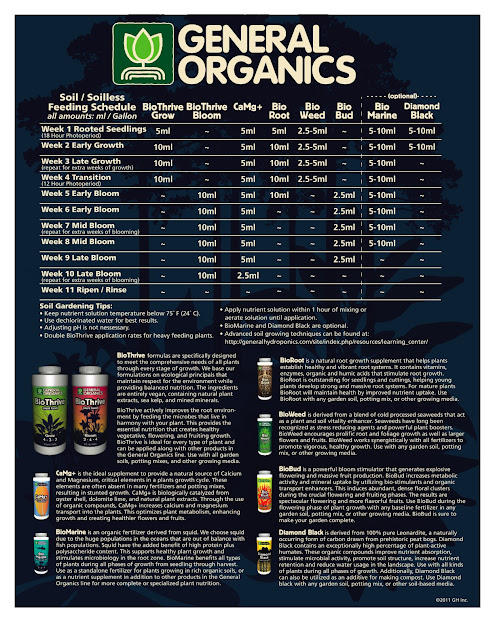Look at what has just arrived on our doorstep! Yes, that’s
right, it’s every girl's dream…a box of organic fertilizers! Could this
day BE any more exciting?? No it could not.
At least that was our initial reaction when this adorable
miniature farmhouse of plant nutrients showed up at our apartment last weekend.
Our enthusiasm lingered just long enough for us to rip open the package, remove
the various colorful bottles, and
come to the unfortunate realization that we had absolutely NO idea what we were
doing (in case you haven’t noticed, this seems to be a common theme). Here’s a
glimpse of what we found inside:
16 oz BioThrive Grow
16 oz BioThrive Bloom
8 oz CaMg+
8 oz BioRoot
8 oz BioWeed
8 oz BioMud
8 oz BioMarine
8 oz Diamond Black
Umm…..what? Should we be totally ashamed to admit we were
expecting one giant bottle that said something along the lines of “Organic
Plant Fertilizer- use daily” ?? Apparently this was going to take even more
research than we originally predicted.
Thankfully, the General Organics website appears to have
been designed specifically with ignoramuses like us in mind. “Growing
vegetables? In soil? Great! Follow this schedule without knowing a THING about
plants and your veggies will grow big and strong and beautiful!”
Okay- seems simple enough, BUT, being the gigantic science
nerd that I am I clearly wanted to know more about what was going on here. After
all, I do have a Master’s degree in nutrition. I could explain to you the path of
Vitamin A in the human body without a second thought, but I literally could not describe how photosynthesis works without a deep investigation into the pages of
Wikipedia. I happen to find this rather embarrassing.
As it turns out, there are tons of resources through the
USDA, state and local departments of agriculture, and local cooperative
extensions that are just dying to teach us city-dwellers a thing or two about
plants and how to grow them. This particular info on plant nutrition was mostly taken from the
North Carolina Department of Agriculture and Consumer Services’ website. The
segment was actually entitled “KidsWorld: Plant Nutrition,” but hey, who am I
to discriminate? Here’s a summary of the basics so you can sound super smart
and informed the next time you happen to be hanging out with a hot group of
organic farmers or botanists (you never know?):
Plants need 3 non-mineral nutrients and 13 mineral nutrients
to survive. Non-mineral nutrients come from air and water: hydrogen, oxygen,
carbon. In photosynthesis, plants use energy from the sun to convert these into
starches and sugar for food! Hooray!
The 13 mineral nutrients come from the soil. Soil doesn’t
always have enough of these nutrients for plants to thrive, which is why we
need these crazy organic fertilizers. The mineral nutrients are divided into
macronutrients and micronutrients.
Primary macronutrients: nitrogen, phosphorus, potassium –
plants need tons of these so they usually need to be added to the soil and are
the main components of fertilizers. Our organic fertilizers source these from natural foods like seaweed and squid. Regular fertilizers add specific ratios of these nutrients, designated on the package in the form N-P-K (nitrogen, phosphorus, potassium).
Secondary macronutrients: calcium, magnesium, sulfur –
calcium and magnesium are usually added to the soil to make it more alkaline
(more on this later), and sulfur comes from decomposing organic matter, like
compost (more on this later, too).
Micronutrients: boron, copper, iron, chloride, manganese,
molybdenum, zinc – again, compost is an excellent source of these minerals, but they can also be added into fertilizers.
There are lots of other factors that play into the nutrient
composition of the soil, like texture, pH, temperature, etc…but this possibly
exceeds the scope of Fertilizing 101... so you will have to stay tuned!



No comments:
Post a Comment